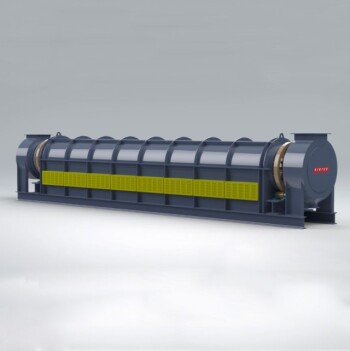The waste tyre pyrolysis plant process involves converting waste tires into valuable products like tire oil, carbon black, steel wire, and gas through a series of controlled thermal decomposition steps. The process begins with the preparation of waste tires, including shredding and removing steel wires, followed by feeding the shredded material into a pyrolysis reactor. The reactor is heated to high temperatures in the absence of oxygen, causing the tires to break down into oil gas, carbon black, and steel wire. The oil gas is condensed into liquid fuel, while non-condensable gases are recycled to heat the reactor. Carbon black and steel wire are collected as by-products. The process is efficient, environmentally friendly, and generates reusable resources from waste materials.
Key Points Explained:
-
Preparation of Waste Tires:
- Shredding: Waste tires are shredded into smaller pieces to facilitate easier processing in the pyrolysis reactor.
- Magnetic Separation: Steel wires embedded in the tires are removed using a wire drawing machine or magnetic separation techniques. This step ensures that the final products are free from metal contaminants.
-
Feeding and Heating in the Pyrolysis Reactor:
- Feeding: The shredded tire material is fed into the pyrolysis reactor.
- Heating: The reactor is heated to temperatures ranging from 400°C to 900°C using fuels such as LPG, wood, coal, or natural gas. The absence of oxygen prevents combustion and ensures the thermal decomposition of the tires.
-
Thermal Decomposition and Product Formation:
- Pyrolysis: At high temperatures, the tire material breaks down into oil gas, carbon black, and steel wire.
- Oil Gas Production: The oil gas produced during pyrolysis is a mixture of hydrocarbons that can be condensed into liquid fuel.
-
Cooling and Condensation:
- Cooling System: The oil gas is passed through a multi-stage cooling system to condense it into liquid tire oil. This oil can be used as fuel or further refined for industrial applications.
- Non-Condensable Gas Recycling: Any non-condensable gases are treated and recycled back into the reactor to provide additional heat, improving the overall energy efficiency of the process.
-
Collection of By-Products:
- Carbon Black: After the reactor cools down, carbon black is discharged and collected using a screw conveyor. Carbon black is a valuable material used in the production of rubber products, inks, and pigments.
- Steel Wire: The steel wire removed during the preparation phase is collected and can be sold as scrap metal or reused in other industrial processes.
-
Environmental and Safety Considerations:
- Smoke Treatment: Smoke generated during the heating process is treated to remove harmful pollutants before being discharged, ensuring compliance with environmental regulations.
- Safety Systems: The plant is equipped with safety and control systems to monitor and manage the pyrolysis process, ensuring safe and efficient operation.
-
Final Product Storage and Dispatch:
- Storage: The liquid tire oil, carbon black, and steel wire are stored in designated containers or silos.
- Dispatch: The final products are dispatched for sale or further processing, completing the waste-to-resource cycle.
This step-by-step process highlights the efficiency and sustainability of waste tyre pyrolysis plants, which not only reduce environmental pollution but also generate valuable resources from waste materials.
Summary Table:
| Step | Description |
|---|---|
| 1. Preparation | Shredding and removing steel wires from waste tires. |
| 2. Feeding & Heating | Shredded tires are fed into a reactor and heated (400°C–900°C) without oxygen. |
| 3. Thermal Decomposition | Tires break down into oil gas, carbon black, and steel wire. |
| 4. Cooling & Condensation | Oil gas is condensed into liquid fuel; non-condensable gases are recycled. |
| 5. By-Product Collection | Carbon black and steel wire are collected for reuse or sale. |
| 6. Environmental Safety | Smoke is treated, and safety systems ensure compliance and efficient operation. |
| 7. Storage & Dispatch | Final products are stored and dispatched for sale or further processing. |
Discover how a waste tyre pyrolysis plant can transform waste into profit—contact us today for more details!








